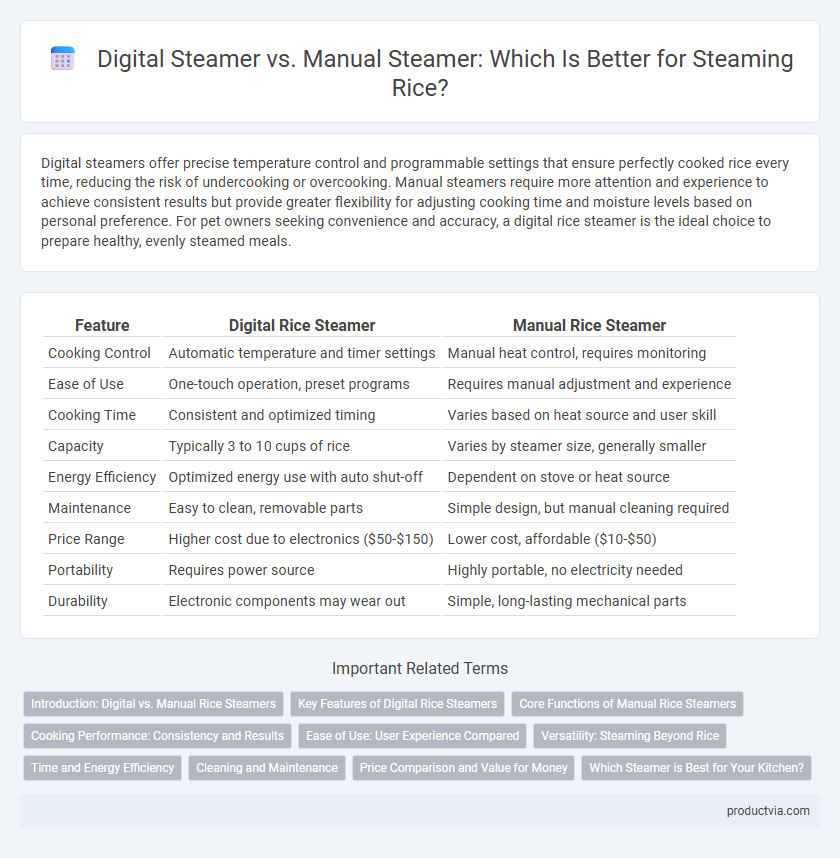Digital steamers offer precise temperature control and programmable settings that ensure perfectly cooked rice every time, reducing the risk of undercooking or overcooking. Manual steamers require more attention and experience to achieve consistent results but provide greater flexibility for adjusting cooking time and moisture levels based on personal preference. For pet owners seeking convenience and accuracy, a digital rice steamer is the ideal choice to prepare healthy, evenly steamed meals.
Table of Comparison
| Feature | Digital Rice Steamer | Manual Rice Steamer |
|---|---|---|
| Cooking Control | Automatic temperature and timer settings | Manual heat control, requires monitoring |
| Ease of Use | One-touch operation, preset programs | Requires manual adjustment and experience |
| Cooking Time | Consistent and optimized timing | Varies based on heat source and user skill |
| Capacity | Typically 3 to 10 cups of rice | Varies by steamer size, generally smaller |
| Energy Efficiency | Optimized energy use with auto shut-off | Dependent on stove or heat source |
| Maintenance | Easy to clean, removable parts | Simple design, but manual cleaning required |
| Price Range | Higher cost due to electronics ($50-$150) | Lower cost, affordable ($10-$50) |
| Portability | Requires power source | Highly portable, no electricity needed |
| Durability | Electronic components may wear out | Simple, long-lasting mechanical parts |
Introduction: Digital vs. Manual Rice Steamers
Digital rice steamers offer precise cooking controls, programmable settings, and automated timers, ensuring consistent texture and optimal moisture retention in every batch. Manual rice steamers rely on traditional steaming techniques, requiring close monitoring and adjustments to achieve the desired rice quality, often resulting in a more hands-on cooking experience. The choice between digital and manual steamers depends on users' preferences for convenience, control, and consistency in rice preparation.
Key Features of Digital Rice Steamers
Digital rice steamers offer precise temperature control and programmable cooking settings, ensuring perfectly cooked rice every time. They often include features like timers, automatic keep-warm modes, and multiple cooking functions suitable for different rice varieties. Advanced sensors in digital steamers adjust steam levels automatically, enhancing convenience and consistency compared to manual steamers.
Core Functions of Manual Rice Steamers
Manual rice steamers offer precise control over steaming duration and temperature, allowing users to tailor the cooking process to different rice varieties for optimal texture and flavor. These steamers rely on simple mechanisms like steam vents and water reservoirs, enabling consistent steam distribution and even cooking without electronic interference. Core functions include adjustable steam levels and a basic timer, ensuring straightforward operation and reliable results for perfectly steamed rice every time.
Cooking Performance: Consistency and Results
Digital steamers offer precise temperature control and programmable cooking times, ensuring consistent rice texture and optimal moisture retention. Manual steamers rely on experience and timing, which can lead to variable results in rice fluffiness and doneness. For consistently perfect rice, digital steamers provide superior cooking performance with repeatable outcomes.
Ease of Use: User Experience Compared
Digital steamers offer advanced features like programmable timers and temperature controls, enhancing ease of use by allowing precise cooking settings for perfect rice. Manual steamers require more attention and experience to monitor progress, making the cooking process less convenient for beginners. User experience with digital steamers is generally more intuitive and efficient, reducing guesswork and improving consistency in rice preparation.
Versatility: Steaming Beyond Rice
Digital steamers offer precise temperature control and preset cooking modes, enabling steaming of diverse foods like vegetables, dumplings, and seafood with consistent results. Manual steamers require careful monitoring and adjustment, limiting their versatility to simpler steaming tasks primarily focused on rice. Choosing a digital steamer enhances culinary flexibility, allowing users to experiment with various ingredients beyond rice effortlessly.
Time and Energy Efficiency
Digital steamers for rice offer precise temperature control and automated cooking cycles that significantly reduce cooking time while optimizing energy consumption. Manual steamers require constant monitoring and adjustments, leading to longer cooking durations and potential energy wastage due to inefficient heat retention. Investing in digital steamers enhances time management and energy efficiency in rice preparation compared to traditional manual steaming methods.
Cleaning and Maintenance
Digital steamers for rice often feature detachable steaming trays and non-stick interiors, simplifying cleaning and reducing residue buildup compared to manual steamers. Manual steamers typically require more effort to disassemble and scrub, especially if rice starch clings to the steaming surface. Regular maintenance of digital steamers extends their lifespan by preventing mineral deposits, while manual steamers may need more frequent deep cleaning to avoid odors and bacterial growth.
Price Comparison and Value for Money
Digital steamers typically cost between $50 and $150, offering precise temperature control and programmable settings that enhance cooking consistency for rice. Manual steamers are generally priced lower, around $20 to $50, but lack automation and require more attention during the cooking process. For customers prioritizing convenience and consistent results, digital steamers provide better value for money despite the higher upfront price, while manual steamers appeal to budget-conscious buyers willing to trade ease of use for lower cost.
Which Steamer is Best for Your Kitchen?
Digital steamers offer precise temperature control and programmable settings for consistently perfect rice cooking, making them ideal for tech-savvy kitchens seeking convenience. Manual steamers require more attention and experience to achieve optimal results, but they offer affordability and simplicity for traditional cooks. Choosing between a digital or manual rice steamer depends on your preference for automation versus hands-on control and your kitchen's technological setup.
Digital Steamer vs Manual Steamer for Rice Infographic

 productvia.com
productvia.com